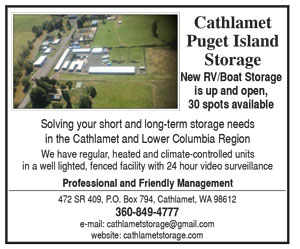Shoreline management rules update unwanted
April 28, 2016
To all Wahkiakum County land owners:
The proposed Shoreline Management Program rules, if enacted, will affect a majority of us. The Dept of Ecology will control your land, not you. Note the following Shoreline Management Program Definitions and Excerpts taken from the Final Draft, ready to be presented to the Commissioners. Add up the set-back distances- you won’t have any land left. While there is still time, tell Dan Cothren, Blair Brady and Mike Backman to reject it.
Shorelines: All shoreline of streams or rivers having a mean annual flow of 20 cubic feet per second or greater. Included are Alger Creek, Beaver Creek, Columbia River, Crooked Creek, Deep River, Elochoman River, Falk Creek, Fall Creek, Fossil Creek, Grays River, Hull Creek, Jim Crow Creek, Klints Creek, Naselle River, Nelson Creek, Otter Creek, Salmon creek, Skamokawa Creek, Stand Creek, West Valley Creek, and Wilson Creek.
Shorelands: Uplands and wetland adjacent to shorelines and includes areas within 200 feet of the OHWM (ordinary high water mark); floodways and contiguous flood plan areas landward 200 feet from such floodways; as well as any associated wetlands.
Shoreland means area extending landward for 200 feet in all directions measured on a horizontal plane (includes hills) from the OHWM; floodways, and contiguous flood plan areas landward 200 feet from such floodways. Note horizontal plane- high grounds and hills are not exempt.
Associated Wetlands; Those wetlands in proximity and influence of streams subject to the Shoreline Manage Act. Typically identified as wetlands are areas that physically extend into the shoreline jurisdiction, or wetlands that are functionally related to the shoreline through surface water connection or other factors. Ecology guidance states that an entire wetland is associated if any part of the wetland lies with the 200 foot jurisdictional landward boundary.
Wetlands generally include swamps, marshes, and bogs that support a prevalence of vegetation typically adapted for soil condition areas frequently inundated or saturated by surface water or ground water.
Shoreline Buffer: required vegetated open space, measured horizontally upland from and perpendicular to the OHWM. Buffer zones are contiguous to shoreline areas required for continued maintenance, function and/or stability of the critical area or shoreline. Buffer widths vary from 25 feet to 300 feet. (Table 4) Buffer functions include protection from disturbance by humans and domestic animals, including footprint modification of any existing structure.
Setback: Area measured 15 feet from outer edge of a critical area buffer.
Site Visits – by a “qualified” administrator, for any project potentially located within 300 feet of a wetland or a wetland buffer or may impact a wetland or its buffer. And guess who pays for that “visit”.
Contact your commissioners. Tell them the Previous Shoreline Management Program already in place is enough. We don’t want the “update”.
Carol Larson
Rosburg






Reader Comments(0)